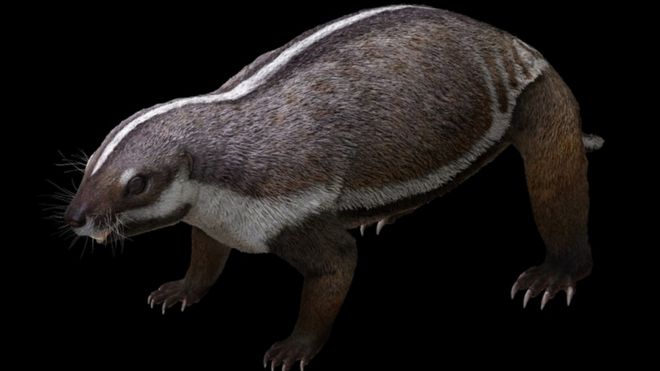
A cat-sized mammal dubbed "crazy beast" lived on Madagascar among some of the last dinosaurs to walk the Earth, scientists have revealed.
MADAGASCAR WAS PART OF LEMURIA
The 66-million-year-old fossil is described in the journal Nature.
Its discovery challenges previous assumptions that mammals were generally very small - the size of mice - at this point in their evolutionary history.
Researchers say this individual animal weighed 3kg (6.6lbs) and had not reached its full adult size.
Scientists think that the badger-like creature, known as Adalatherium hui, would have burrowed.
It had a large collection of nerves in the snout, making this area extremely sensitive - a feature frequently seen in burrowing animals.
Before mammals took over the Earth, they probably had to run and hide from the much larger dinosaurs that ruled our planet - not to mention other predators.
The fossil specimen was found in 1999 in north-west Madagascar's Mahajanga Basin.
It is the most complete and best-preserved mammal find from Gondwana - an ancient southern supercontinent that once included India and Africa - during the time of the dinosaurs.
However, when this mammal was alive, Gondwana was breaking up, and Madagascar had already become an island.
The team members think Adalatherium would have faced different types of predator, as well as different food sources, on the island to mammals living on the mainland. This may have led to the animal evolving its large size.
The very complete specimen gives scientists a rare insight into a branch of mammals - known as Gondwanatherians - that have now gone extinct.
The name "Adalatherium" is translated from the Malagasy and Greek languages and means "crazy beast".
Its discovery "bends and even breaks lots of rules", said David Krause of Denver Museum of Nature and Science, who led the research.
According to the tectonics, Madagascar and India were indeeheory of plate d once part of the same landmass (thus accounting for geological resemblances), but plate movement caused India to break away millions of years ago, and move to its present location.
Lemuria (continent) - Wikipedia
https://en.wikipedia.org › wiki › Lemuria_(continent)
The name "Adalatherium" is translated from the Malagasy and Greek languages and means "crazy beast".
Its discovery "bends and even breaks lots of rules", said David Krause of Denver Museum of Nature and Science, who led the research.
According to the tectonics, Madagascar and India were indeeheory of plate d once part of the same landmass (thus accounting for geological resemblances), but plate movement caused India to break away millions of years ago, and move to its present location.
Lemuria (continent) - Wikipedia
https://en.wikipedia.org › wiki › Lemuria_(continent)
No comments:
Post a Comment